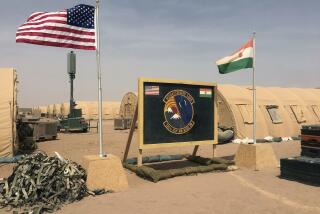Syrian government says it’s retaken key city near Damascus
The Syrian government said Thursday that its forces had taken back the strategic industrial city of Adra just northeast of Damascus, ending its almost yearlong occupation by rebels.
The recapture of Adra, situated close to the main highway north from Damascus to Homs, would appear to be the latest success for government troops fighting to secure the capital and its environs.
The ongoing series of U.S.-led airstrikes on Islamic State militants in northern and eastern Syria has galvanized international attention on the effort to destroy the group. But on the ground in Syria, the war between rebels and forces loyal to the government of President Bashar Assad grinds on.
The Islamic State is just one of scores of opposition factions fighting the government, though it is among the most powerful and radical in ideology. Battles between Syrian troops and rebels have been ongoing along on several fronts throughout the country.
The Syrian conflict is now in its fourth year and has left some 190,000 people dead, according to the United Nations. Much of the nation remains out of control of the central government in Damascus.
A major strategic goal of thinly stretched pro-government forces has been to push rebels away from the capital, Assad’s seat of power. The capture of Adra, after days of reportedly heavy fighting, would enhance the capital’s security from rebel attack and restrict insurgent access to the main north-south highway and nearby military installations.
In the last year, the army has taken back a number of formerly opposition-held suburbs of Damascus, either through attacks or truces negotiated with area residents. Many neighborhoods have been largely destroyed in the process.
The main highway north from Damascus features burned-out hulks of buildings in the Jobar, Qaboun and Harasta districts, all scenes of fierce fighting in the last year. But the center of Damascus has been largely spared from the widespread destruction.
Despite ongoing military actions, much of the Ghouta area to the east and northeast of Damascus remains an opposition bastion. Adra is just north of Douma, a rebel stronghold in the Ghouta expanse.
Rebels linked to a number of Islamist factions, including the Nusra Front, the official Al Qaeda franchise in Syria, overran Adra in December, seizing industrial facilities and apartment towers housing workers.
The government accused the rebels of massacring dozens of civilians, singling out members of minority sects such as Alawites, Christians, and Druze, all viewed as largely loyal to the Assad government. Syrian authorities also accused the rebels of taking civilians hostage and using them as “human shields” to hold off an army advance.
Opposition activists have generally denied that rebels massacred civilians in Adra, home to a cement plant and a number of large manufacturing facilities.
The Syrian conflict has featured numerous allegations by both sides of massacres on the ground, often sectarian-fueled. But independent access to alleged massacre sites and to witnesses has been difficult, thwarting efforts by human rights monitors and journalists to investigate the allegations.
In recent days, opposition activists alleged that government forces had used poison gas in their drive to recapture Adra, killing several people and wounding others. The Syrian government has denied the charge and has accused the opposition of several poison-gas strikes.
An independent watchdog group, the Organization for the Prohibition of Chemical Weapons, concluded in a report this month that a toxic chemical, likely chlorine, had been used in deadly attacks on villages in northern Syria earlier this year. But the Hague-based organization did not say who likely deployed chlorine, an industrial substance widely used in water purification and other processes.
Special correspondent Nabih Bulos contributed to this report.
More to Read
Sign up for Essential California
The most important California stories and recommendations in your inbox every morning.
You may occasionally receive promotional content from the Los Angeles Times.








